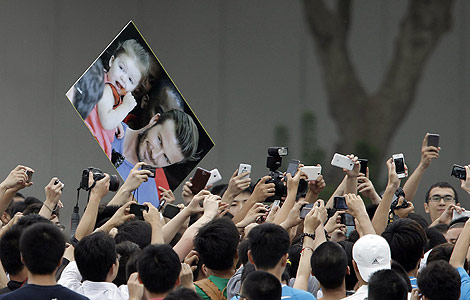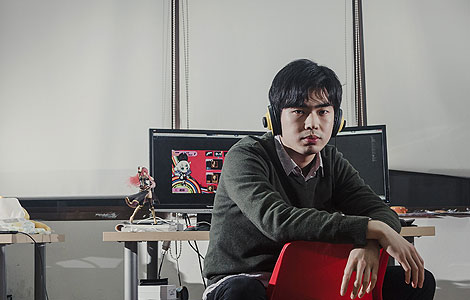A science class from above Earth
Updated: 2013-06-21 02:22
By Xin Dingding in Beijing and Fu Jing in Brussels (China Daily)
|
||||||||
Commander Nie Haisheng made a show of crossing his legs in the air in a meditation posture — which only a martial arts master can do in the movies, but is impossible for people on Earth.
Wang smiled as she pushed Nie into the wall of the module with a gentle nudge of her hand, and went on to gulp down a floating drop of water.
"Thanks to the weightless condition, we're all masters," she joked.
The two then conducted a string of experiments that demonstrated how objects behave in low gravity — from a bubble of water to a spinning toy.
Wang started with a question of how astronauts measure weight in the weightless orbiter.
|
 |
|
Wang Yaping, the second Chinese woman in space, demonstrated how a variety of objects — from a spinning toy to a bubble of water — behave in space. Xinhua |
Nie demonstrated by measuring his weight on the special scale onboard the orbiter, which was designed on the basis of Newton's second law of motion, or measuring the mass of an object through net force and acceleration.
It was followed by an experiment where she held out a small ball tied to a string. "What will happen if I let the ball go?" she asked.
The ball did not swing as it would on Earth but stayed suspended. When she pushed the ball gently, the ball moved in a circular motion, which stirred the classroom a bit.
Wang later pushed a static gyro and a moving gyro to change the way they move.
What appeared to excite students most were the experiments with water.
Wang made a film of water with a metal ring, and then a ball of water to explain how zero gravity magnified surface tension.

 7 injured at Beckham event
7 injured at Beckham event
 A science class from above Earth
A science class from above Earth
 Chinese telecom companies call on Myanmar
Chinese telecom companies call on Myanmar
 June PMI signals weakness
June PMI signals weakness
 Rising demand sends producers overseas
Rising demand sends producers overseas
 Michelle lays roses at site along Berlin Wall
Michelle lays roses at site along Berlin Wall
 Historic space lecture in Tiangong-1 commences
Historic space lecture in Tiangong-1 commences
 'Sopranos' Star James Gandolfini dead at 51
'Sopranos' Star James Gandolfini dead at 51
Most Viewed
Editor's Picks

|

|

|

|

|

|
Today's Top News
China urges resumption of six-party talks
SEC charges China-based firm with fraud
Bank of China denies monetary default report
Snowden's future hangs in balance
China reiterates support for the UN
Dairy measures start at source
June PMI signals weakness
Drug-related crimes on the rise in Xinjiang
US Weekly

|

|







